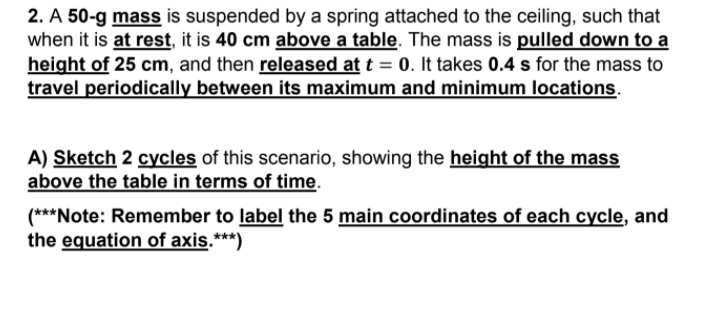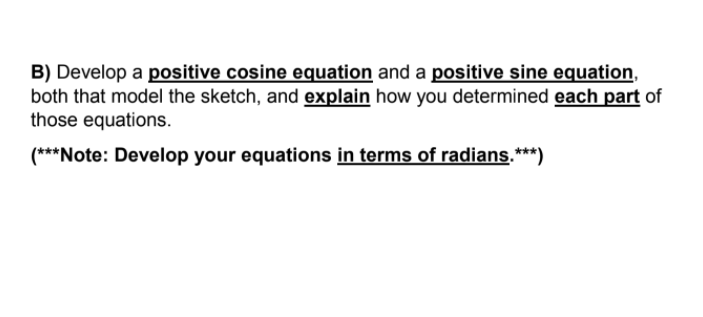. A 50-g mass is suspended by a spring attached to the ceiling, such that hen it is at rest, it is 40 cm above a table. The mass is pulled down to a eight of 25 cm, and then released at t = 0. It takes 0.4 s for the mass to avel periodically between its maximum and minimum locations. ) Sketch 2 cycles of this scenario, showing the height of the mass bove the table in terms of time. **Note: Remember to label the 5 main coordinates of each cycle, and ne equation of axis.***)
. A 50-g mass is suspended by a spring attached to the ceiling, such that hen it is at rest, it is 40 cm above a table. The mass is pulled down to a eight of 25 cm, and then released at t = 0. It takes 0.4 s for the mass to avel periodically between its maximum and minimum locations. ) Sketch 2 cycles of this scenario, showing the height of the mass bove the table in terms of time. **Note: Remember to label the 5 main coordinates of each cycle, and ne equation of axis.***)
Elements Of Electromagnetics
7th Edition
ISBN:9780190698614
Author:Sadiku, Matthew N. O.
Publisher:Sadiku, Matthew N. O.
ChapterMA: Math Assessment
Section: Chapter Questions
Problem 1.1MA
Related questions
Topic Video
Question

Transcribed Image Text:2. A 50-g mass is suspended by a spring attached to the ceiling, such that
when it is at rest, it is 40 cm above a table. The mass is pulled down to a
height of 25 cm, and then released at t = 0. It takes 0.4 s for the mass to
travel periodically between its maximum and minimum locations.
A) Sketch 2 cycles of this scenario, showing the height of the mass
above the table in terms of time.
(***Note: Remember to label the 5 main coordinates of each cycle, and
the equation of axis.***)

Transcribed Image Text:B) Develop a positive cosine equation and a positive sine equation,
both that model the sketch, and explain how you determined each part of
those equations.
(***Note: Develop your equations in terms of radians.***)
Expert Solution
This question has been solved!
Explore an expertly crafted, step-by-step solution for a thorough understanding of key concepts.
This is a popular solution!
Trending now
This is a popular solution!
Step by step
Solved in 2 steps with 2 images

Knowledge Booster
Learn more about
Need a deep-dive on the concept behind this application? Look no further. Learn more about this topic, mechanical-engineering and related others by exploring similar questions and additional content below.Recommended textbooks for you

Elements Of Electromagnetics
Mechanical Engineering
ISBN:
9780190698614
Author:
Sadiku, Matthew N. O.
Publisher:
Oxford University Press

Mechanics of Materials (10th Edition)
Mechanical Engineering
ISBN:
9780134319650
Author:
Russell C. Hibbeler
Publisher:
PEARSON

Thermodynamics: An Engineering Approach
Mechanical Engineering
ISBN:
9781259822674
Author:
Yunus A. Cengel Dr., Michael A. Boles
Publisher:
McGraw-Hill Education

Elements Of Electromagnetics
Mechanical Engineering
ISBN:
9780190698614
Author:
Sadiku, Matthew N. O.
Publisher:
Oxford University Press

Mechanics of Materials (10th Edition)
Mechanical Engineering
ISBN:
9780134319650
Author:
Russell C. Hibbeler
Publisher:
PEARSON

Thermodynamics: An Engineering Approach
Mechanical Engineering
ISBN:
9781259822674
Author:
Yunus A. Cengel Dr., Michael A. Boles
Publisher:
McGraw-Hill Education

Control Systems Engineering
Mechanical Engineering
ISBN:
9781118170519
Author:
Norman S. Nise
Publisher:
WILEY

Mechanics of Materials (MindTap Course List)
Mechanical Engineering
ISBN:
9781337093347
Author:
Barry J. Goodno, James M. Gere
Publisher:
Cengage Learning

Engineering Mechanics: Statics
Mechanical Engineering
ISBN:
9781118807330
Author:
James L. Meriam, L. G. Kraige, J. N. Bolton
Publisher:
WILEY